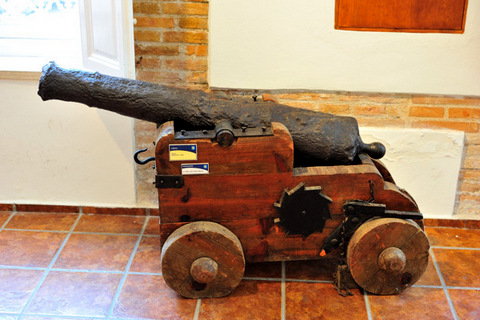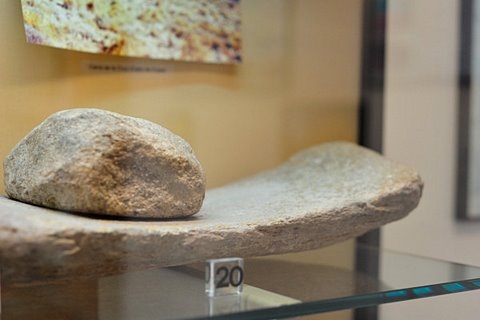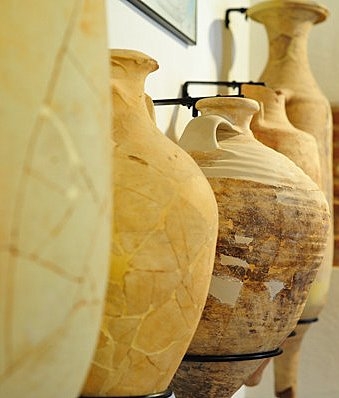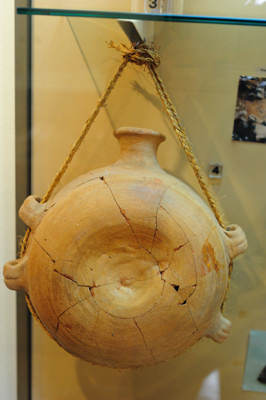Contact Águilas Tourist Office on +34 968 493 285
Send an Email
Click Here

The Museo Arqueológico de Águilas contains a collection of artefacts relating to the history of the municipality, with representative displays relating to each of the important phases and cultures which settled in this coastal location.
Click to read the History of Águilas

Prehistory
Águilas has been inhabited for approximately 5000 years, with several sites showing prehistoric settlements,  amongst them Cabo de Cope, Peñarrubia, Tébar, Chuecos, Fuente del Sol and Barranco de los Asensios. A common feature of these settlements is that they are close to supplies of fresh water for all or part of the year, and the archaeological findings are mainly stone axes and rudimentary ceramic pottery. Prehistoric remains have been found in the cave known as C-6, in Cabe Cope dating to around 3,000 BC, at the end of the Neolithic period, where a quantity of ceramics, as well as the residues of the food eaten including seagull egg shells, give valuable information to archaeologists about the type of diet, the flora and fauna of the period and the tools used by these early settlers .
amongst them Cabo de Cope, Peñarrubia, Tébar, Chuecos, Fuente del Sol and Barranco de los Asensios. A common feature of these settlements is that they are close to supplies of fresh water for all or part of the year, and the archaeological findings are mainly stone axes and rudimentary ceramic pottery. Prehistoric remains have been found in the cave known as C-6, in Cabe Cope dating to around 3,000 BC, at the end of the Neolithic period, where a quantity of ceramics, as well as the residues of the food eaten including seagull egg shells, give valuable information to archaeologists about the type of diet, the flora and fauna of the period and the tools used by these early settlers .
This is the first known site of permanent habitation in the area.
Águilas, Argaric Culture and Phoenicians
The second millennium BC in Águilas was characterized, as in the rest of the Region of Murcia, by the  dominance of the Argaric culture, and here the Argaric settlements were a natural continuation of those which already existed in the Neolithic. The people lived off livestock and wheat, and used objects made from bronze, including weapons which allowed them to defend their territory. The Argaric culture was predominant from around 1800 BC to around 1300 BC. This was a highly structured society, which demonstrated a clear social and organisational hierarchy, using uniform ceramics to control measures of grain, transporting raw materials and minerals throughout the various settlements and controlling specialised production of food, metal goods and ceramics.
dominance of the Argaric culture, and here the Argaric settlements were a natural continuation of those which already existed in the Neolithic. The people lived off livestock and wheat, and used objects made from bronze, including weapons which allowed them to defend their territory. The Argaric culture was predominant from around 1800 BC to around 1300 BC. This was a highly structured society, which demonstrated a clear social and organisational hierarchy, using uniform ceramics to control measures of grain, transporting raw materials and minerals throughout the various settlements and controlling specialised production of food, metal goods and ceramics.
They were succeeded by the Iberians, who were active between 525 BC and 50 BC, who gradually adopted Roman customs and ways of working following the Roman invasion in 209BC and disappeared as a definable culture during the period of peak Roman occupation.
The remains of an Iberian settlement have been found in Tébar, dating from the first millennium BC, an  agricultural culture which traded actively with traders from the Mediterranean basin, absorbing their influences and skills to create sophisticated ceramics and metalwork.
agricultural culture which traded actively with traders from the Mediterranean basin, absorbing their influences and skills to create sophisticated ceramics and metalwork.
Amongst these traders were the Phoenicians who used trading ports along the southern coast of the peninsula from the 7th century BC onwards, and various archaeological sites have been found along the coastline of Águilas which confirm that they traded here. The remains of salted fish factories have been found in Villaricos, La Huerta del Consejero and the Isla del Fraile, these salt fish factories producing pungent fish sauces which were traded throughout the Mediterranean, using tanks in which the fish were macerated and salted.
Águilas and the Romans
The Romans played an important ròle in the development of the whole of what is now the Region of Murcia,  when Cartagena was invaded in 209 BC. The Romans controlled the coast and its trading ports meticulously, building the first watchtower on a hill they named “Aquilae”, giving rise to the name of Águilas in later centuries, and there are substantial signs of occupation in the area for the next three centuries. The thermal baths which are now part of a museum in the city centre were built during this period, as was the “agora” or main square which is nowadays the Glorieta de España.
when Cartagena was invaded in 209 BC. The Romans controlled the coast and its trading ports meticulously, building the first watchtower on a hill they named “Aquilae”, giving rise to the name of Águilas in later centuries, and there are substantial signs of occupation in the area for the next three centuries. The thermal baths which are now part of a museum in the city centre were built during this period, as was the “agora” or main square which is nowadays the Glorieta de España.
The high point of Aquilae’s splendour came in the last centuries of the Roman Empire, the 3rd and 4th AD. At this time one of the main sources of income and wealth was the production of salted fish and garum sauce and in Aquilae there were also pottery factories where the amphorae for storing and transporting the food were produced. The salted fish factory in Águilas consists of a large central room where the fish was treated, with a series of adjoining areas, of varying sizes, for salting and other purposes. In addition to pottery and fish-based products, the town was also an important source of grapes and olives, and a centre for the harvest  and export of esparto grass.
and export of esparto grass.
Near the Puerto del Hornillo various family burial areas have been found, and it is thought that ships and boats for the Roman fleet could also have been built there.
The display cabinets focus on the main elements of the finds recovered, with one dedicated to the process of salt fish manufacture, one dedicated to domestic products discovered in the streets of calle Sagasta and Quintana and another explores the funerary world with a recreation of a child burial in the late Roman necropolis of Cabezo del Molino and another burial in the 3rd century cemetery of Calle Aire, together with personal belongings recovered.
There is also a good collection of coins, both Roman and Mediaeval.
Finally the bloated Roman Empire disintegrated, splitting into two as Europe was subjected to raids from the Germanic tribes of central and northern Europe and by the 5th century the Vandals had reached this area of the Iberian peninsula, followed by the Visigoths.There is virtually no evidence of occupation during this period, and it is not until the invasion of the Moors in 713 AD that archaeological evidence again yields informtion about the former inhabitants of Águilas.
Mediaeval, Modern and Contemporary
This period is represented by materials which have come from the Monte del Castillo de San Juan, dating  from the Islamic occupation of Águilas. Although the Moors took the Iberian peninsula in 713 AD, the remains found in Águilas date primarily from the 11th to the 13th centuries.
from the Islamic occupation of Águilas. Although the Moors took the Iberian peninsula in 713 AD, the remains found in Águilas date primarily from the 11th to the 13th centuries.
Many of the artifacts found in Águilas relate to a burial ground found in the Calle San Juan below the fortress, and relate to dwellings which would have existed below the Moorish Hisn, or fortification, which formerly occupied the rocky outcrop.
As Moorish power waned and many troops were withdrawn from Spain to fight a succession battle in Morocco, the Christian forces of the Kingdoms of Castile and Aragon moved south, slowly taking the cities and settlements of Spain in their relentless push for domination.
The Treaty of Alcaraz in 1243 meant that the kingdom of Murcia became a protectorate of Castile, and for Águilas this also meant that the town was practically deserted for two centuries, a dangerous place to live, as it was close to the border with the last remaining Moorish kingdom of Granada, border towns frequently subjected to skirmishes and incursions.
Visiting the Archaeological Museum in Águilas.
The Archaeological Museum is just around the corner from the Plaza de España, which is one of the most  atmospheric locations in Águilas to enjoy an open air coffee or granizado in the summer. A visit to the Museum could easily be combined with a visit to the castle in the same morning, or as part of a longer around town route.
atmospheric locations in Águilas to enjoy an open air coffee or granizado in the summer. A visit to the Museum could easily be combined with a visit to the castle in the same morning, or as part of a longer around town route.
This can also form part of group visits to the town.
Opening Hours
Click here to see opening times of museums and places of interest in Águilas
Telephone: 968 493 287
Entry free of charge
For further information visit the Águilas town page.




Hello, and thank you for choosing CamposolToday.com to publicise your organisation’s info or event.
Camposol Today is a website set up by Murcia Today specifically for residents of the urbanisation in Southwest Murcia, providing news and information on what’s happening in the local area, which is the largest English-speaking expat area in the Region of Murcia.
When submitting text to be included on Camposol Today, please abide by the following guidelines so we can upload your article as swiftly as possible:
Send an email to editor@camposoltoday.com or contact@murciatoday.com
Attach the information in a Word Document or Google Doc
Include all relevant points, including:
Who is the organisation running the event?
Where is it happening?
When?
How much does it cost?
Is it necessary to book beforehand, or can people just show up on the day?
…but try not to exceed 300 words
Also attach a photo to illustrate your article, no more than 100kb
